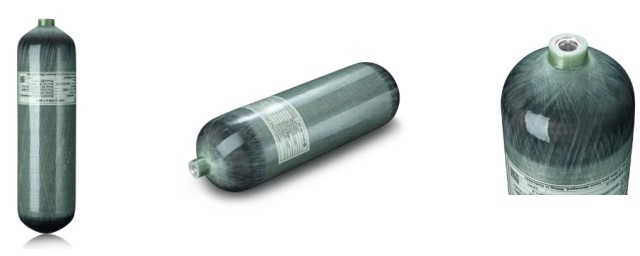Carbon fiber cylinders are widely used in industries where lightweight, high-strength, and high-pressure storage is critical. Among these cylinders, two popular types—Type 3 and Type 4—are often compared due to their unique materials and designs. Both have their advantages and limitations, depending on the specific use case. This article delves into the key differences between Type 4 and Type 3 carbon fiber cylinders, helping users make informed decisions for their applications.
Overview of Type 4 and Type 3 Cylinders
Before discussing the differences, it is essential to understand the basic construction of each type:
- Type 4 Cylinders: These are fully wrapped composite cylinders with a polymer liner (PET) as the inner core.
- Type 3 Cylinders: These feature an aluminum liner wrapped with carbon fiber for structural strength, often with an additional layer of fiberglass for protection.
Both types are designed to hold high-pressure gases, but their construction materials significantly impact performance, weight, durability, and lifespan.
Key Differences Between Type 4 and Type 3 Cylinders
1. Material Composition
- Type 4 Cylinders:
Type 4 cylinders use a PET liner as the inner structure, which is much lighter than aluminum. This liner is then fully wrapped with carbon fiber for strength and plus an outer multi-layer cushioning fire-retardant protective layer. - Type 3 Cylinders:
Type 3 cylinders have an aluminum liner, providing a rigid, metal core. The carbon fiber wrap adds strength, while an outer layer of fiberglass offers additional protection.
Impact: The lighter PET liner in Type 4 cylinders makes them significantly lighter than Type 3 cylinders, which is a crucial factor in weight-sensitive applications.
2. Weight
- Type 4 Cylinder Weight: 2.6 kg (excluding rubber caps)
- Type 3 Cylinder Weight: 3.7 kg
The Type 4 cylinder weighs about 30% less than the Type 3 cylinder of the same capacity. This weight reduction can make a significant difference in applications like self-contained breathing apparatuses (SCBAs), where users must carry the cylinder for extended periods.
3. Lifespan
- Type 4 Cylinder Lifespan: No-limited-lifespan (NLL)
- Type 3 Cylinder Lifespan: 15 years
The Type 4 cylinder does not have a predetermined lifespan if maintained properly, whereas Type 3 cylinders typically have a service life of 15 years. This difference can affect long-term costs, as Type 4 cylinders do not require periodic replacement.
Impact: Type 4 cylinders offer better long-term value in applications where durability and longevity are critical.
4. Durability and Corrosion Resistance
- Type 4 Cylinders: The PET liner in Type 4 cylinders is non-metallic, making it inherently resistant to corrosion. This is especially beneficial in humid or corrosive environments.
- Type 3 Cylinders: The aluminum liner in Type 3 cylinders, while strong, is susceptible to corrosion over time if exposed to moisture or improper maintenance.
Impact: For applications in harsh environments, Type 4 cylinders have an advantage due to their corrosion resistance.
5. Pressure Ratings
Both cylinder types can handle the following working pressures:
- 300 bar for air
- 200 bar for oxygen
The pressure ratings are similar, ensuring that both types are suitable for high-pressure applications. However, the non-metallic liner of Type 4 cylinders provides additional safety against gradual chemical reactions that could compromise the structural integrity of the aluminum liner in Type 3 cylinders over time.
Application Scenarios
Both Type 4 and Type 3 cylinders serve similar applications but may excel in different environments:
- Type 4 Cylinders:
- Best for weight-sensitive applications like firefighting, SCBAs, or portable medical oxygen systems.
- Ideal for humid or corrosive environments due to their non-corrosive PET liner.
- Suitable for long-term use cases where lifespan is a critical factor.
- Type 3 Cylinders:
- Suitable for applications where slightly heavier but highly durable cylinders are acceptable.
- Commonly used in industrial settings or scenarios where the lifespan limitation of 15 years is not a concern.
Cost Considerations
While Type 4 cylinders are often more expensive upfront due to their advanced materials and design, their longer lifespan and lighter weight can offset the initial cost over time. Type 3 cylinders, with their lower initial cost, are suitable for users with budget constraints or short-term needs.
Conclusion
Choosing between Type 4 and Type 3 carbon fiber cylinders requires careful consideration of the application, budget, and environmental factors.
- If lightweight design, corrosion resistance, and long lifespan are top priorities, Type 4 cylinders are the clear choice. Their advanced materials and design make them ideal for demanding applications like firefighting, diving, and emergency services.
- If cost-efficiency and durability are more critical, and the application does not require extended lifespan or resistance to harsh environments, Type 3 cylinders provide a reliable option.
By understanding the strengths and limitations of each cylinder type, users can select the most suitable option for their needs, ensuring safety, performance, and value over time.
Post time: Dec-18-2024



